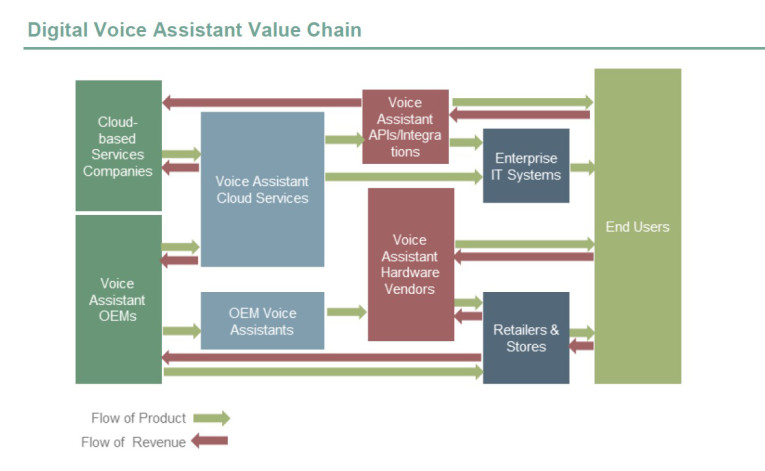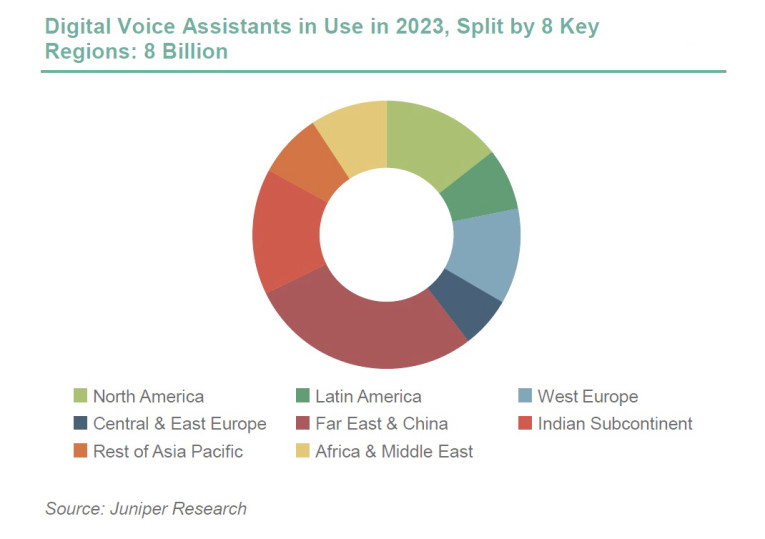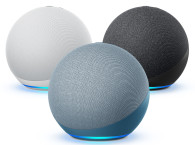
After the launch of the Amazon Echo in 2014, the rest of the Big Five technology companies (Apple, Facebook, Google, Microsoft), Samsung and a host of smaller companies all began releasing their own digital assistants on a variety of platforms. With an increasing number of these assistants integrating third party apps and functionalities, their scope and capabilities is reaching the point where they can be used to provide and facilitate many services in consumers’ lives and the beginnings of B2B (Business to Business) usage can be seen.
The adoption of voice assistants has been one of the fastest-growing trends in consumer technology, whether through standalone devices or existing mobile devices. One particular consequence of this device explosion is that, as simpler interactions become outsourced entirely to voice assistant devices, reducing screen time on smartphones. There are also indications that smart speaker voice assistants are becoming integrated in to daily routines in a way that voice assistants on other platforms are not. This means that voice-only interactions will become increasingly expected in the future.
 Despite this, smart displays are a voice assistant device category that has emerged strongly within the past 12 months, alongside tablets and tablet docks designed to offer contextual smart display functionality. Both of these developments hint that voice assistants are now looking to provide multimodal support, with Google in particular noting that more than half of Assistant interactions on smartphones involve both voice and touch.
Despite this, smart displays are a voice assistant device category that has emerged strongly within the past 12 months, alongside tablets and tablet docks designed to offer contextual smart display functionality. Both of these developments hint that voice assistants are now looking to provide multimodal support, with Google in particular noting that more than half of Assistant interactions on smartphones involve both voice and touch.While smartphone assistants will be the largest platform by volume thanks to Google Assistant and Siri, Juniper’s new research found that the fastest growing voice assistant categories over the next 5 years will be:
1. Smart TVs - 121.3% CAGR
2. Smart speakers - 41.3% CAGR
3. Wearables - 40.2% CAGR
In these categories, Amazon’s Alexa has already established itself as the leader; setting the pace for the market. In addition, Chinese companies will make inroads internationally in the future.
Enterprise voice assistants are emerging for both B2B (Business to Business) and B2C (Business to Consumer) uses; B2C as a platform for delivering products and services to the consumer, and B2B as a way of handling a variety of administrative and information tasks within a company. In B2B deployments, voice assistants are finding their biggest home in the organizational space, with their largest degree of usage being intelligently sorting and booking meetings and appointments. These can range from conference call scheduling to office cleaning, depending on how the assistant is deployed within a given company.
The use of voice assistant hardware as a conference calling tool is also of particular interest to businesses. Voice assistants that integrate with a calendar (most notably Google Assistant and Microsoft’s Cortana) can access any conference details held in the calendar and connect a meeting with a simple verbal command. In addition to this, several companies are providing facilities to automatically record calls and email recordings, transcripts or both to participants.
The new research, "Digital Voice Assistants: Platforms, Revenues & Opportunities 2019-2023," notes that, as demand for multi-platform assistants increases, standalone apps, made by independent vendors for smartphones and tablets, will decline. Juniper expects revenues from these apps to begin to fall in key markets from 2022.
The big exception here is China, where companies like WeChat and Alibaba provide app-based offerings alongside speakers that are not part of an operating system. This means that China will have 78% of voice assistant apps installed globally in the next 5 years.

Juniper’s report also shows that voice commerce will grow substantially; reaching over $80 billion per annum by 2023. However, this includes money transfer and purchases of digital goods alongside its use for more traditional purchases.
“We expect the majority of voice commerce to be digital purchases, until digital assistants offer truly seamless cross-platform experiences” remarked research author James Moar. “Connected TVs and smart displays are vital here, as they can provide a visual context that is lacking in smart speakers.”
For more insights into what this diversity of platforms means for the future of digital voice assistants, Juniper offers a free whitepaper download, The Digital Assistants of Tomorrow, available here.
www.juniperresearch.com






